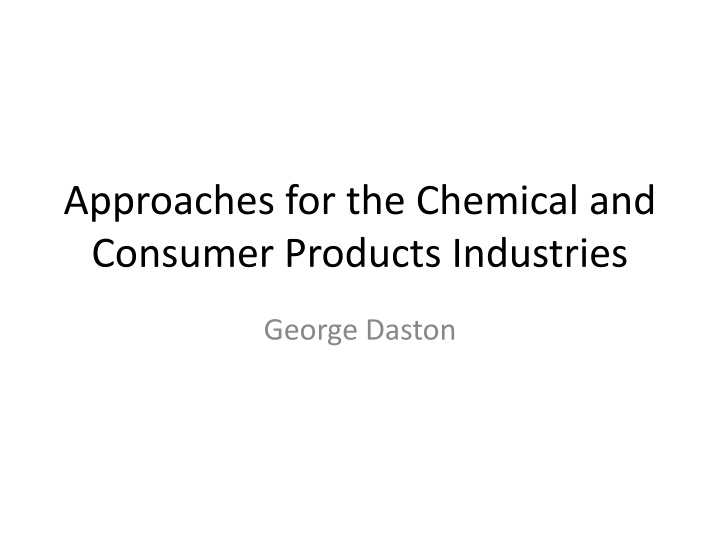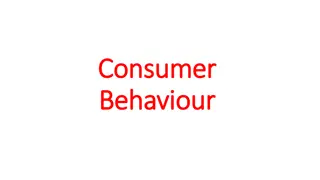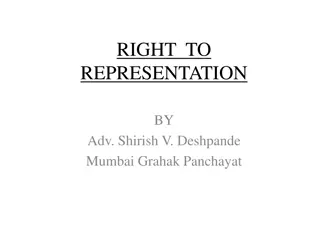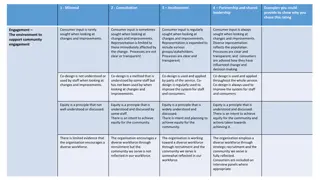Regulatory Frameworks and Risk Assessment in Chemical and Consumer Industries
Explore the intricate regulatory landscape encompassing laws like REACh, TSCA, and the EU Cosmetics Directive, which govern the chemical and consumer products industries. Dive into concepts such as risk assessment, predictive toxicology, and the use of analogs in decision-making. Discover how these frameworks guide safe chemical usage while enhancing product quality.
Download Presentation

Please find below an Image/Link to download the presentation.
The content on the website is provided AS IS for your information and personal use only. It may not be sold, licensed, or shared on other websites without obtaining consent from the author.If you encounter any issues during the download, it is possible that the publisher has removed the file from their server.
You are allowed to download the files provided on this website for personal or commercial use, subject to the condition that they are used lawfully. All files are the property of their respective owners.
The content on the website is provided AS IS for your information and personal use only. It may not be sold, licensed, or shared on other websites without obtaining consent from the author.
E N D
Presentation Transcript
Approaches for the Chemical and Consumer Products Industries George Daston
Many Laws and Regulations! US California Prop. 65 AB 1879 Japan Chemical Substances Control Act Cosmetics Law Canada Environmental Protection Act TSCA FIFRA FDCA CPSA FHSA EU REACh Cosmetics Directive
A few relevant examples REACh: mandatory registration of chemicals in commerce in Europe Provides opportunity for read-across, if supported TSCA: regulates most chemicals in US Provides some flexibility in data streams A big criticism has been the difficulty in getting data for most of the 70K chemicals in commerce, and we have seen how ToxCast and ExpoCast can provide some help in prioritizing EU Cosmetics Directive: amended to prohibit animal testing after March 2013
REACh read-across framework Six read-across scenarios Based on two generic hypotheses Metabolism to a common intermediate Similar biological activity
Risk Assessment: 21stcentury version Predictive toxicology assays Concentration -response BPAC UFs (Confidence adjust) TK BPAD variability
Risk Assessment by Analogy Animal Toxicity Data Dose-response BMD UFs Chemical similarity Common metabolism Common MOA (Confidence adjust) PK adjust TK TD Acceptable Level Analog variability
Predictive Toxicology workflow exposure High quality analogs Cheminformatics PK Models decision More data needed Systems biology models Rapid Lab Methods
Sixty Years of Toxicology Data ACToR: aggregator of data on over 500,000 chemicals, 1000 data sources Number of literature references by endpoint: Repeat-dose toxicity: 16,000 Carcinogenicity: 15,000 DART: 11,000 Acute tox: 69,000 Data are searchable by chemical structure
Suitable Analogs O O H3C O H3C O CH3 CH3 CH3 CH3 H3C H3C CAS# 80-27-3 CAS# 8007-35-0 HO HO OH OH O O O O O O OH OH CAS# 1338-43-8 CAS# 8007-43-0
Possibly Suitable HO HO OH OH O O O O O O OH OH CAS# 1338-43-8 CAS# 1338-92-3
Unsuitable Analogs O O H ALDH O O VS HO O O O Nu- hepatocellular nucleophiles O O CAS# 177406-46-1 CAS# 131-17-9 H O Nu hepatotoxicity
Organizing Data Chemical structures associated with specific modes of action Can be arranged in a decision tree structure to facilitate and enhance search strategies
Expert system decision tree for repro/dev toxicity No I Metallic Known precedent reproductive & developmental toxic potential derivatives; org. phosphours; organosiloxanes 1) As, B, Mn,Cr, Zn, Te acids, oxides; Al, Cd, Cu, Zn,Mn, Ni, Pb chlorides or Pb, Hg Me deriv. Sn triphenyl deriv;2) organo phosphonates/phosphonamides /phosphonic acids; 3) phenyl di-/tri- siloxanes, phenyl cyclo tri-/tetra-siloxanes Yes 1) Toluene/small alkyl (<C4) toluene; 2) alkyl/nitro benzenes; 3) poly-Cl-benzene; 4) poly/Cl/NO2 oxdibenzene; 5) di-Br, I, Cl,di-NO2phenol & precursors (esters) 1) BMHCA- like; 2) aryl/heteroaryl (C1-C3) acids; 3) alpha aryloxy (C1- C3) acids, esters Yes Chemicals III Core structure contains aromatic or hetero aromatic ring No No Yes No 1 Nucleotide & nucleobase deriv.1) Uridine-, cytidine-,aza cytidine-like;2) pyrimidine-, purine-like Organic compds Yes Yes No ER& ARbinders: 1) E2, gluco-, mineral-coticoid, progestrone & androgen receptor binders;2) flavones & myco estrogen; 3) DES-,BPA-,tamoxifen-, DDT-like, alkylphenols,salicylates, parabens, phthalates, alkoxy phenols;4) N-aryl amides, ureas & carbamides etc. No Yes 8 9 Opioid/tubline binders: 1) morphines, mepridine- like; 2) bezimidizole carbamides, bezimidizolyl thiazole, 3) podophyllo- toxins, 4) cochincine-like, noscapine,taxel-like, epothilone deriv. No II Yes Yes 1) Aryl/heteroaryl sulfon amides, aryl sulfonureas, N- heteroaryl amino-benzene sulfon-amides; 2) phenyltoins 7 Yes Contains acyclic ring Yes 10 1) vitamin D3- like; 2) tridemorph-like (alky C11-C14); 3) OH, Cl methyl or alkoxymethyl (R<C9) oxiranes; 4) amino glycoside-, streptomycine- like; 5) poly-Cl mono/fused/ bridged cyclic compds Yes 6 2 1) barbital-, ETU, PLTU- like; 2) allantoin-, dimethadione- like No No Yes No Yes 1) Arylethan amines, 2) cyclizine-like deriv No RAR/AhR binders & Prostaglandin receptor agonists: 1) retinoid deriv, acitretin-like; 2) TCDD-like, HAHs, PAHs,indigo, indole-like, FICZ; 3) prostaglandin E1-like Yes Ion channel/beta-adrenergic/ ACE/ARA inhibitors; Shh signaling interference/ cholesterol synthesis inhibition: 1) HERG/sodiumchannel inhi- bitors; 2) pindolol-like; 3) enalapril-,trandolapril-,quinapril- ,candesartan-like; 4) cyclopamine-like, triparanol, AY9944, BM15766 11 17 nAChRs binders: 1) atropine-like, 2) diphen hydr- amine, glyco- pyrrolate, pro- cyclidine-like; 3) piperidine, pyrro- lidine alkaloids No IV Yes No No No 1) 2,4-diamino pyrimidine- like; 2) benzidineazo & methylaminoazo benzenes; triarylmethan dyes; 3) pyridyl or aryl triazenes No Mono-/multi- functional groups subst. (at the terminal carbon) < C9 hydrocarbons (substituents: amine, SH(=S), OH,OR, acetyl,helogene, CN) Miscellaneous cyclic chemicals: ascorbic acid; cycloheximide; hinokitiol 16 5 4 3 12 18 V VI Yes No < C9 carboxylic acids, their deriv. (esters, amides, ureas, thioureas carbamates); 2) vinyl amides, <C4 vinyl aldehydes & esters 1) Imidazole deriv, 2) nitro imidazoles, nitrofuran deriv; 3) triazole deriv Yes Yes No 1) -halogenated (Cl, Br) acetic acid; - hydroxyl. -alkoxyl (-OR, R is < C5 alkyl chain); - alkyl (C2 to C3) substituted carboxylic acids or their esters; 2) adipatederivates Saturated, < C9 carboxylic acids/ esters Yes Yes 13 No Yes 1) Cumarin-, thalidoamide-like; benzodiazepins; 2) pheniramine-,promazine- imipramine-, hexahydro dibenzo pyrazinoazepine-like; 3) tetracyclines No 1) Helogenated/multi- halogenated (Cl, Br) < C4 alkanes, alkenes, ethers and acetonitriles; 2) N, S mustard-like Miscellaneous non- cyclic chemicals: Methylazoxy methyl acetate; hexane; 2- hexanone;2,5-hexane dione; multihalo genated acetones (HFA), (TCA); meprobamate Yes No No 22 1) Vinyl amides,aldehydes & esters; 2) C1-C4amides andN-alkyl amides, ureas, thioureas, carbonate, carbamates, guanidine; formamides No No 1) Alkyl carbamodi- thioic acids; 2) alkyl sulfonates 14 Yes Yes No 23 Yes No 19 20 Yes 21 Miscellaneous aromatic chemicals & antibiotics: aminopyrridine, aminonicotinamide,emodin, actinomycinD, phencyclidine, ketamine, mitomycin C, puromycin No No No Yes No known precedent repro/dev toxic potential Known precedent reproductive & developmental toxic potential Di-/multi-functional groups (amine, SH (=S), OH, OR, acetyl, CN) subst.(at each terminal carbon) C1 to C5 hydrocarbon or repeating C2 units No 1) C1-C4 non- branched/<C9 -alkyl (<C5) subst. alcohols; 2) <C4 alkyl-, vinyl nitriles No No known precedent repro/dev toxic potential 24 15 Yes 25 Yes
Putative MOA Grouping by Chemical Structure 25 major categories, multiple sub-categories Highest level of confidence has Similar structures Identified molecular target Similar DART outcome (e.g., common syndrome or highly specific effect) Along with toxicogenomics, has the potential to accelerate assigning MOA to DART compounds
Outcome of chemistry assessment is hypothesis generation Chemical is metabolized to a tested analog (or analog and new compound have the same active metabolite) Currently, assessment is done by wet lab metabolism Chemical is sufficiently similar in structure to analogs of known toxicity that similar biological activity is inferred assessment can be done by MOA-specific evaluation, if MOA is known Global analysis of gene expression HTS (e.g., ToxCast) Other methods
Predictive Toxicology workflow exposure High quality analogs Cheminformatics PK Models decision More data needed Systems biology models Rapid Lab Methods
Two Close Structural Analogs DEHP DINP
Connectivity Mapping: High-throughput toxicogenomics Concept developed by Lamb in 2006 A relatively small number of carefully selected cell types contained all of the pathways necessary to define gene expression profiles for all therapeutic agents in current use Can we do the same for toxicants? Cell types: rich in either small molecule receptors or metabolizing enzymes
MOAs to Interrogate with CMAP Estrogens, environmental estrogens Anti-estrogens PPAR agonists Anti Androgens Androgens CAR/PXR agonists RAR agonists TR agonists AhR agonists Vitamin D agonist Glucocorticoid receptor agonists EGFR receptor agonists FXR receptor agonists Progesterone receptor agonists EGFR antagonist Steroid synthesis inhibitors HDAC inhibitors Folate/one-carbon metabolism inhibitor Glycolytic inhibitors Oxidative phos/mitochondral inhibitors Iron chelators Microtubule inhibitors Liver cholestasis inducers
Cell Types Cells enriched for small molecule receptors MCF-7 Ishikawa Cells with hepatocyte characteristics Hep G2 Hepa RG iCell
Ketoconazole analogs ketoconazole isoconazole sulconazole econazole sertaconazole butoconazole miconazole
Next steps More cell types MCF-7 HepG2 A549 Keratinocytes Renal epithelium More chemicals (108 in phase 2) More modes of action More analog pairs/ series More data analysis methods To optimize the ability to distinguish single MOA from multiple MOA (from non-specific responses) More focus on concentration-response
Predictive Toxicology workflow exposure High quality analogs Cheminformatics PK Models decision More data needed Systems biology models Rapid Lab Methods
Estimating internal concentration Chemical structure Physiological descriptors and their variability From literature Concentration PBPK model From the computer Phys-chem property prediction Time Partition coefficients for different organs Metabolism, protein binding data From the lab
1b face leave on 2x 2 3 100 100 100 80 80 80 60 60 60 40 40 40 20 20 20 0 0 0 100 200 300 400 100 200 300 400 100 200 300 400 % abs (new) % abs (new) % abs (new) 100 100 100 80 80 80 60 60 60 40 40 40 20 20 20 0 0 0 0 50 100 0 50 100 0 50 100
Conclusions Computational methods are available that enable use of the entire toxicology literature to understand the toxicity of untested chemicals Methods to screen by MOA are available but we need to establish how many MOAs there are MOA-based screening needs to be connected to adverse outcome PK methods Anchoring to analogs Systems biology models
Acknowledgements Cheminformatics Shengde Wu Karen Blackburn Jorge Naciff Joan Fisher Cathy Lester Toxicogenomics Jorge Naciff Yuching Shan Xiaohong Wang Jay Tiesman Greg Carr Nadira deAbrew In silico PBPK Joanna Jaworska John Troutman External Justin Lamb Willis Read-Button Rusty Thomas Barbara Wetmore Ed Carney























